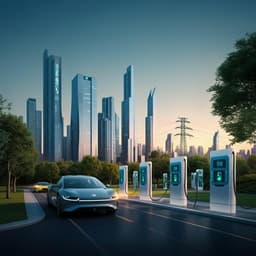
Environmental Studies and Forestry
Pricing indirect emissions accelerates low-carbon transition of US light vehicle sector
P. Wolfram, S. Weber, et al.
Discover how the large-scale adoption of electric vehicles can lead to a surprising reduction in overall emissions while also boosting sales, thanks to innovative policies explored by researchers Paul Wolfram, Stephanie Weber, Kenneth Gillingham, and Edgar G. Hertwich.
Playback language: English
Introduction
Global transportation is the largest energy user and CO2 emitter, primarily due to light-duty vehicles (LDVs). To curb emissions, many countries promote alternative fuel vehicles with lower tailpipe emissions. However, concerns exist about increasing emissions from energy production and vehicle manufacturing, which are indirect emissions. These indirect emissions include electricity generation for charging electric vehicles and vehicle production. Recent studies reveal significant variability in gasoline production emissions, ranging from below 15 to ~320 g CO2/kWh in 2015, compared to direct tailpipe emissions of about 250 g CO2/kWh. In 2020, indirect emissions accounted for approximately 26% of the 1.5 Gt CO2 caused by the US LDV fleet. Current transport policies rarely address these indirect emissions comprehensively. The study aims to analyze the impact of pricing both direct (tailpipe) and indirect emissions on the low-carbon transition of the US LDV sector. This is crucial because it could alter the relative costs of different vehicle propulsion options (BEVs, HFCEVs, ICEVs) and thus influence manufacturing and consumer choices. Integrated energy models (IEMs) are often used to assess climate change mitigation pathways, but they often don't fully represent the interdependencies between sectors and may lack the technological detail for accurate analysis. This research addresses these gaps by using a comprehensive framework focusing on energy-demand-side solutions, using the Energy Information Agency’s National Energy Modeling System (NEMS) linked to a detailed vehicle life cycle assessment (LCA) model. This combination allows for a holistic analysis of all vehicle emissions across the supply chain, investigating the influence of holistic emissions pricing on the competitiveness of different vehicle technologies under the assumption that production costs of electric vehicle batteries and renewable electricity generators fall rapidly.
Literature Review
Existing literature highlights the significance of reducing greenhouse gas emissions from the transportation sector, particularly from light-duty vehicles. Studies have shown the potential of electric vehicles in reducing tailpipe emissions, but they also raise concerns regarding increased indirect emissions associated with electricity generation and battery production. The impact of indirect emissions on optimal decarbonization pathways has been investigated in the context of electricity supply, with some studies reporting a limited role. However, the transportation sector presents a unique challenge due to the larger share of indirect emissions compared to the electricity sector. The lack of comprehensive policies regulating all sources of vehicle emissions along the entire supply chain is also noted in the literature. Integrated energy models (IEMs) are widely used for energy and climate policy evaluations, but their limitations in fully capturing the impacts of changes in one sector on emissions in others have been identified. The research paper draws on the call for stronger research focus on demand-side solutions for mitigating climate change and utilizes a transdisciplinary demand-side assessment framework to perform a comprehensive climate change mitigation analysis of the US LDV sector.
Methodology
The study employed a novel methodology combining two established modeling approaches: integrated energy modeling (IEM) and life cycle assessment (LCA). The primary IEM used was the Energy Information Agency’s National Energy Modeling System (NEMS), specifically a modified version called 'Yale-NEMS'. Yale-NEMS is an integrated energy model that simulates energy supply and demand across various sectors, including transportation, electricity, and buildings. The model incorporates detailed representations of vehicle technologies and fuel pathways, allowing for a comprehensive analysis of emission sources. Crucially, the researchers modified Yale-NEMS to include indirect emissions associated with vehicle manufacturing, electricity generation, and fuel production, reflecting a holistic life cycle approach. This model determines equilibrium energy supply and demand, providing annual energy supply and demand projections in each energy market through 2050. Economic drivers were exogenously supplied, whereas world energy prices, supply and demand, and US energy imports and exports were calculated endogenously. Yale-NEMS includes an extensive inventory of different vehicle types with various powertrains and sizes. These are then selected based on prices, energy use, and consumer and manufacturer behavior. The model includes 12 vehicle sizes, 86 fuel efficiency technologies, and 16 alternative propulsion technologies, and factors in fuel production methods. Vehicle manufacturers make production decisions based on production costs, CAFE requirements, and potential regulatory costs. The model was further refined by updating vehicle costs using bottom-up estimates, incorporating projections of rapidly declining costs of lithium-ion batteries and renewable electricity generation based on economies of scale and technological advancements. The researchers 'soft-linked' Yale-NEMS to a detailed vehicle LCA model, iterating between the two to account for the full life-cycle emissions of different vehicle technologies. The LCA model covers CO2 emissions from fuel production and combustion, electricity generation, material production and recycling, assembly and reuse, and lightweighting. A 'feebate' system was implemented in Yale-NEMS to incorporate indirect emission costs into the vehicle choice procedure, influencing both production and sales decisions. The LCA model used Yale-NEMS outputs (vehicle weights, lightweighting degree, energy consumption, battery sizes, electricity carbon intensity, and carbon prices) as calibration coefficients to calculate per-vehicle life-cycle carbon emissions and associated carbon prices. These prices were then fed back to Yale-NEMS, impacting the vehicle choice decision-making process. The two models iterated until convergence was reached. Several side cases explored uncertainties in the cost of renewable electricity, the cost of EV batteries, and the role of hydrogen fuel cell vehicles. The scenarios include a linear carbon tax increase in the transport sector from 2021 to 2050. The main scenarios compared the impact of pricing only tailpipe emissions versus pricing both tailpipe and indirect emissions.
Key Findings
The study's key findings demonstrate that pricing both direct (tailpipe) and indirect emissions leads to a faster phase-out of gasoline-powered vehicles than pricing only direct emissions. Specifically, the transition is accelerated under full emissions pricing, resulting in a near-complete phase-out of internal combustion engine vehicles (ICEVs) and a complete avoidance of hydrogen fuel cell electric vehicles (HFCEVs). This is driven by the high emissions penalty associated with hydrogen production from natural gas. The decrease in sales of ICEVs, HFCEVs, and other powertrains (hybrids and flex-fuel vehicles) is offset by substantially higher sales of battery electric vehicles (BEVs). This substitution pattern peaks around 2040, leading to cumulative avoided sales of nearly 29 and 9 million units of ICEVs and HFCEVs, respectively. The cumulative life-cycle emissions through 2050 are substantially lower (-1.6 Gt CO2) under full emissions pricing compared to only pricing direct emissions. This reduction is mainly due to lower fuel combustion (-1.4 Gt CO2) and lower gasoline and hydrogen production (-0.5 Gt CO2). Although BEV sales increase electricity emissions, this increase is far smaller (+0.25 Gt CO2) than the reduction in emissions from fuel production (-0.5 Gt CO2). The additional 30 Mt CO2 embodied in vehicle production due to increased BEV sales can potentially be offset by improved recycling and reuse practices. Sensitivity analyses using various side cases (different hydrogen production pathways, different BEV-HFCEV cost-competitiveness) showed the robustness of the overall findings. The exception is scenarios with constant renewable electricity costs, where full emissions pricing does not yield lower emissions than direct emissions-only pricing. The average real-world fuel economy of the fleet improves greatly in all scenarios, and even more so when full life-cycle emissions are priced, attributable to the accelerated penetration of BEVs. Further, pricing supply chain emissions leads to reductions in gasoline and diesel consumption (29% and 32% lower in 2050, respectively, compared to only taxing direct emissions) and a significant decrease in hydrogen demand (-99.9%). While electricity use increases (18%), overall energy use decreases (7%). The overall material demand is slightly higher (2.1%), with a noticeable increase in copper demand (4.7%). These effects are primarily caused by higher BEV sales. The difference between the two main scenarios is that under full pricing, cumulative gasoline consumption is reduced by 0.15 trillion gallons compared to direct-emissions-only pricing, representing a whole year's US gasoline consumption. Similarly, significant amounts of hydrogen are saved (0.8 PWh), while electricity consumption is higher by 3.2 PWh (roughly the current annual amount of electricity end-use in the US). Cumulative material use for vehicle production is slightly higher, mainly driven by larger BEV stock. Material substitutions and more ambitious recycling can more than offset the higher demand for virgin materials. Under the scenarios analyzed, the US LDV sector would require 3–5% of the global carbon budget, which is approximately its share of current emissions.
Discussion
The study's findings challenge the conventional understanding of the role of indirect emissions in optimal decarbonization pathways. Previous research focusing on electricity supply has reported a limited role for indirect emissions. This study, however, reveals that indirect emissions play a significantly larger role in the LDV sector (about a quarter of total life-cycle emissions today, increasing to almost half in 2050), altering optimal climate change mitigation pathways. The counter-intuitive result that pricing indirect emissions actually *accelerates* BEV adoption and reduces overall emissions highlights the importance of considering the full life cycle. The simultaneous reduction of both direct and indirect emissions under full emissions pricing indicates a win-win situation for climate change mitigation, provided the electricity supply continues to decarbonize. The surprising finding that non-tailpipe emissions are lower with full pricing contradicts the common perception of 'dirty' batteries and electricity. The study highlights the need for broader policy scopes, encompassing all sources of vehicle emissions throughout the entire life cycle. The results suggest that the US, and likely other nations with suitable low-carbon electricity grids, should prioritize BEV deployment, with HFCEVs possibly viable alternatives if production costs of fuel cells and low-carbon hydrogen decrease significantly.
Conclusion
This research demonstrates that incorporating indirect emissions into climate policies significantly accelerates the transition to low-carbon transportation. The unexpected finding that pricing indirect emissions leads to higher BEV sales and lower overall emissions underscores the importance of holistic life-cycle assessments in policy design. The methodology used offers a valuable framework for integrating dynamic life-cycle relationships into integrated modeling frameworks. Future research should explore additional factors like CCS at fuel refineries, differences in emission intensities of fuels, net-negative emission pathways, low-carbon steel production, regional variations, and the inclusion of pollutants beyond CO2. The study's findings advocate for comprehensive policy adjustments to regulate all sources of vehicle emissions across the supply chain, promoting a faster and more effective low-carbon transition.
Limitations
The study's primary limitations stem from assumptions related to technological advancements, cost projections, and policy interventions. The rapid cost declines of batteries and renewable energy sources are based on projections which may not accurately reflect future realities. The model assumes a linear increase in carbon prices in the transportation sector, a simplification of potential future carbon pricing policies. The model assumes that vehicle production occurs within the US, disregarding potential variations in emission intensities due to global supply chains and manufacturing location. The study focuses on CO2 emissions and may not fully capture the impacts of other greenhouse gases and pollutants. Additionally, consumer behavior and market dynamics are simplified in the model, potentially affecting the accuracy of sales projections. The study also does not explicitly model the costs of electric vehicle chargers or consumer discounting of future costs, factors that could influence consumer adoption of EVs. Finally, although the uncertainty of future costs of electric vehicle batteries and renewable power generators are explored via various side cases, there are still inherent uncertainties in these cost projections that may impact the outcomes.
Related Publications
Explore these studies to deepen your understanding of the subject.







